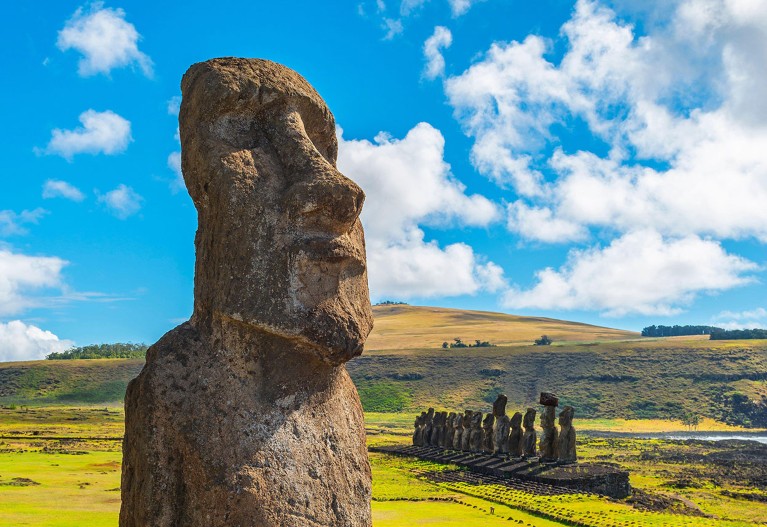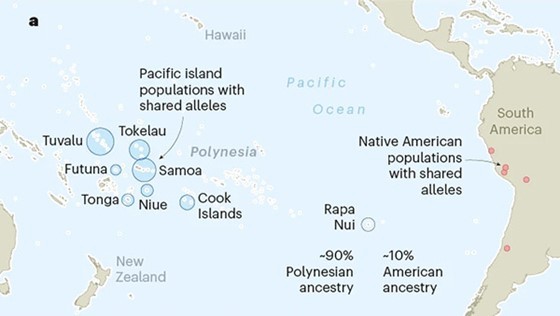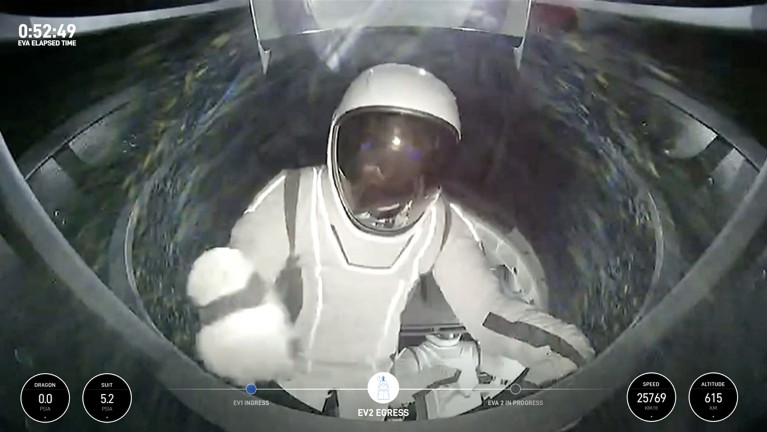Hello Nature readers, would you like to get this Briefing in your inbox free every day? Sign up here.

Rapa Nui is known for its giant stone figures, called moai.Credit: Sébastien Lecocq/Alamy
A study of ancient genomes has dispelled the theory that early inhabitants of Rapa Nui (also known as Easter Island) ravaged its ecosystem and caused the population to crash. Researchers analysed the DNA of ancient and modern Rapanui individuals and found no sign of a ‘population bottleneck’ that would have indicated a collapse. This study, done with the endorsement of and input from officials and Indigenous community members in Rapa Nui, “serves as the final nail in the coffin of this collapse narrative”, says archaeogeneticist Kathrin Nägele.

Genomes from ancient Rapa Nui people are predominantly of ancestries similar to those of other Pacific islanders, but around 10% of their genetic material can be traced to ancestors from coastal areas of what is now called South America. The findings suggest that Rapanui people made contact with people from these regions hundreds of years before Europeans first visited the island. (Infographic from the Nature News & Views article (7 min read, Nature paywall)
Two studies, both including more than 100,000 women, have revealed a suite of genes that help to regulate when a person enters menopause. In women included in a UK health data registry, researchers found nine genetic variants associated with age at menopause. Variants in four of the genes were also linked to a higher risk of cancer. The second study relied on data from postmenopausal women in northern Europe and found that those with certain variants of the gene CCDC201 underwent menopause nine years early on average.
References: Nature paper & Nature Genetics paper
On Tuesday, US presidential hopefuls Kamala Harris and Donald Trump stepped up to the debate podiums. Science issues took a back seat to the economy, immigration and national security, but candidates exchanged views on abortion and women’s health, the country’s relationship with China and the climate. Nature analyses what the candidates did and did not say about science, and hears what researchers think about the candidates’ stances.
An analysis of peer reviews published by some journals alongside their papers has highlighted a scheme that might allow reviewers to benefit from duplicated or generic reviews. The analysis identified 263 suspicious reviews published by 37 journals between 2021 and 2024. Marketing researcher Maria Ángeles Oviedo-García, the author of the study, suspects that reviewers are using templates to quickly churn out reviews and boost their own professional standing, or in some cases receive credit toward future publishing fees. “Some other researchers will probably base their future research on those fake-reviewed papers, and it’s scary,” she says.
Reference: Scientometrics paper
Features & opinion
Some physicians call it the ‘South Asian paradox’: heart disease is common for people of South Asian ancestry, despite fewer of the usual risk factors, such as smoking. “Everywhere you look, in every single South Asian group and diaspora, there is this risk which we cannot explain,” says epidemiologist Mohammed Ali. But genetic data that could shed light on the root cause is scarce. Projects aiming to dig into genetic evidence are underway, but critics worry that a focus on the genetics and genomics of a broadly defined population oversimplifies the issue. “I support the idea of doing more analysis of genetic risk factors,” says epidemiologist Nishi Chaturvedi. “But I think that’s being done at the cost of looking at whole-of-life determinants of diabetes and cardiovascular disease.”
Data relevant to the Sustainable Development Goals (SDGs) are riddled with gaps. It’s part of the reason why only 17% of SDG targets are on track to be achieved by the end of this decade, argue Yongyi Min and Haoyi Chen of the United Nations Statistics Division and Francesca Perucci of Open Data Watch. Data gathering by citizens can help. A set of guidelines called the Copenhagen Framework on Citizen Data can help to accelerate SDG implementation and uphold its overarching ‘leave no one behind’ principle — but implementing the framework won’t be easy.
In July, a devastating wildfire blazed through Jasper National Park in Canada, destroying much of the town of Jasper — and it is still burning. But the damage could have been much worse, notes a group of forest scientists, a historian and an Indigenous fire-stewardship leader. “Proactive fuel mitigation in the forests surrounding Jasper has meant that firefighters were able to save around 70% of the town’s infrastructure,” they write. To respond to Canada’s ever-worsening wildfires, the researchers recommend combining technological advancements in data acquisition with Indigenous-led stewardship.
Image of the week

SpaceX engineer Sarah Gillis, shown here climbing from the spacecraft’s hatch, made history today as one of the first private citizens to complete a spacewalk.Credit: SpaceX
Engineer Sarah Gillis (along with entrepreneur Jared Isaacman) made history today by making the first privately funded excursion outside a spacecraft. They poked their upper bodies out of the hatch of their SpaceX Dragon capsule at a peak altitude of more than 700 kilometres. The crew’s mission, Polaris Dawn, is the second space outing funded by Isaacman, with two more on the cards. (Nature | 6 min read) (SpaceX)
Today I’m marvelling at ‘self-medicating’ gorillas in Gabon. Researchers kept track of which plants a group of western lowland gorillas (Gorilla gorilla gorilla) were eating. Working with local healers, they found that four of these plants had medicinal properties. Each of these four plants even showed activity against at least one strain of multidrug-resistant E. coli.
Let us know if you’re marvelling, or otherwise, at this newsletter at [email protected]
Thanks for reading,
Jacob Smith, associate editor, Nature Briefing
With contributions by Flora Graham
Want more? Sign up to our other free Nature Briefing newsletters:
• Nature Briefing: Microbiology — the most abundant living entities on our planet — microorganisms — and the role they play in health, the environment and food systems.
• Nature Briefing: Anthropocene — climate change, biodiversity, sustainability and geoengineering
• Nature Briefing: AI & Robotics — 100% written by humans, of course
• Nature Briefing: Cancer — a weekly newsletter written with cancer researchers in mind
• Nature Briefing: Translational Research — covers biotechnology, drug discovery and pharma


